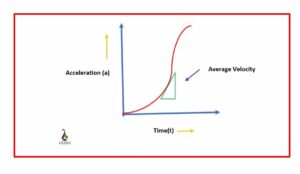If a motion involves constant acceleration, we can learn an easy method how to find average velocity on a acceleration time graph in this article.
To know how to find average velocity on a acceleration time graph, we must know that the Vavg of an object is measured by dividing the total change of position seen in a motion concerning the time taken to complete that motion. Similarly, on A-T graph by measuring the slope of the initial and last points of the plot.
Now let us know how to find average velocity on the acceleration time graph in detail.
How to find average velocity on a position-time graph

To find average velocity on a P-T graph, we have to know some basic ideas that are as follows,
In general, we know that Vavg is calculated based on the criteria of position and time; these two are essential in measuring Vavg, So the thing we can do is assign the values and label the axis, then plot it. Draw a slope to the curve, mark any two points, and consider the initial and endpoints. The value of this slope will be Vavg.
Now let us know about the acceleration time graph.
Acceleration-time graph

There are many relation graphs in physics to find quick values of specific quantities.
Acceleration time graphs are one of those crucial graphs. We require to convert a velocity-time graph into an acceleration time graph to find out specific values, i.e., by finding the derivative of certain values such as average velocity. We can take the slope of a line tangent to the curve drawn at the graph at any point.
Now, as we learned about the A-T graph, let us know about its features.
Features of Acceleration Time graph following average velocity.

The essential features of the acceleration time graph in accordance with calculating average velocity is as follow,
- To find Vavg on the A-T graph, after doing all the labeling and plotting, and joining of values.
- Draw a slope, and that slope is called jerk. Here slope values will be equal to the total average velocity.
- In the case of constant acceleration, s should calculate the slope value for the obtained horizontal line, which is termed average velocity.

After all this, it’s time to see the different aspects of this approach.
Aspects of acceleration time graph and average velocity
The different aspects of the acceleration time graph and average velocity can be seen below,
- The acceleration time graph of all the objects that moves with constant V will be similar.
- The object might be a large airplane or small ant, and the graph will be the same, differing in their values.
- The graph will be collinear on the x-axis (horizontal line).
- The V will be similar for all these objects in their reference.
How to find average velocity on a acceleration time graph?
There are specific steps to find the V on the acceleration time graph.
First and foremost, we have to note the initial velocity and the constant acceleration of the body in motion.
Then use this acceleration and find out the final velocity.
After finding all the values, plot them on the A-T graph.
- Consider any two points and draw a slope.
- Then measure the area under that curve and use the formula
- The formula includes distance and time, use the average velocity formula and derive it from obtaining the term used to measure average values.
- Later the tangent and slope are drawn to give us the value of the required V.
This way, we can find the average velocity on an acceleration time graph.
Relation between acceleration time graph and average velocity
To find V., we sometimes use an acceleration time graph. There are two critical cases of acceleration in measuring average velocity.
- Both the quantity’s average velocity and acceleration do not depend on each other.
- If there is more acceleration, then the change in velocity will be maximum, but it does not tell about velocity at a particular time. Here we get the overall value of velocity termed average velocity.
- Coming to the other case, if the acceleration is constant, the A-T graph will be linear. Here the average velocity will be similar at all the points.
Now let us solve some problems to understand them better.
Problems to find average velocity using acceleration time graph.
Here are some problems to solve to understand the concept better.
Problem 1
The initial velocity of the body moving in the positive direction is zero, but as it moves, its acceleration is 9m/s; find its velocity will be at 8s?
Solution:
∆V = a∆t
∆V = (9.8m/s)(1.0s)
∆V = 9.8m/s
Now the final velocity is to be calculated
∆V = a∆t
∆V = (9 m/s) (8s)
∆V = 72m/s
If we find this on the acceleration time graph, we will find the average velocity by calculating the area under the curve.
It is one of the fundamental problems to solve on V on an A-T graph.
Different Approaches to find Average velocity
Average velocity can be found mainly by two methods that are illustrated below,
- With the help of specific formula, we can find average velocity in many ways by using distance or position change of the object on a path at a specific time.
- We can even use calculus to find out the required average velocity.
- Another method to find out Vavg is using certain graphs such as a position-time graph, Velocity-time graph, and even an acceleration-time graph.
- By plotting the data values, and later by following specific steps, it is possible to calculate average velocity.
The approaches mentioned earlier are the primary methods used to find average velocity.
To study about instantaneous velocity
Frequently Asked Questions | FAQs
What is average velocity from acceleration and time?
On an acceleration time graph, the average velocity of a body is calculated by considering two points on the plot.
If the acceleration is variable, there is slight difficulty measuring the average velocity on the acceleration time graph. Still, if the acceleration is constant, Vavg can be found by adding the body’s velocity in the beginning and at the end using a specific formula.
How do you find the average velocity average from acceleration and time?
The average velocity that is usually denoted in Vavg can be given as follows with the usage of acceleration and time.
We are using acceleration that is denoted as a and time as t, with the help of distance and time. We can follow specific steps and derive a formula with the help, we can measure the Vavg of a body; the formula is given below.
S = vi + ½at2
vavg = s/t = vi + ½at2
vavg = vi + ½ (vf – vi)
vavg = (vf – vi)
That is, acceleration multiplied with time equals the total change in velocity.
What is a Velocity-time graph?
Even velocity-time graph is one of the essential graphs in physics.
It is an actual representation of the object’s change in velocity during the motion according to the time taken. The graphs may be of any type depending on the constant and variable aspects. If the velocity is rapid, the graph’s line will not be horizontal to any axis, and vice-versa if there is any variable term, then the graph’s line will be parallel to the axis.
What is an acceleration-time graph?
The acceleration time graph involves acceleration and time respectively on the x and y-axis.
The graph of acceleration v/s time is plotted according to the time taken by an object to move on a linear path. This graph can find the average velocity depending on the constant and variable acceleration. The graph value is represented in the form of y= a(t). The unique feature of this graph is we can find both positive and negative values of velocity and even acceleration.
Also Read:
- How to find acceleration on a velocity vs time graph
- How to calculate negative velocity
- How to find horizontal velocity of a projectile
- How to calculate velocity in magnetic fields
- How to determine velocity in quark gluon plasma
- How to determine velocity using light clocks
- How to determine velocity in molecular orbitals
- Negative constant velocity graph
- Negative velocity example
- How to find constant acceleration with velocity and time

I am Raghavi Acharya, I have completed my post-graduation in physics with a specialization in the field of condensed matter physics. I have always considered Physics to be a captivating area of study and I enjoy exploring the various fields of this subject. In my free time, I engage myself in digital art. My articles are aimed towards delivering the concepts of physics in a very simplified manner to the readers.